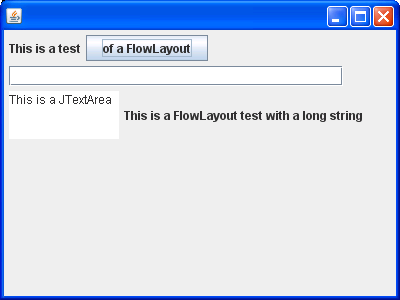
import java.awt.Container;
import java.awt.FlowLayout;
import javax.swing.JButton;
import javax.swing.JFrame;
import javax.swing.JLabel;
import javax.swing.JTextArea;
import javax.swing.JTextField;
public class FlowLayoutBehaviour extends JFrame {
public static void main(String[] args) {
FlowLayoutBehaviour ft = new FlowLayoutBehaviour();
ft.setDefaultCloseOperation(JFrame.EXIT_ON_CLOSE);
ft.setSize(400, 300);
ft.setVisible(true);
}
public FlowLayoutBehaviour() {
super();
Container pane = getContentPane();
pane.setLayout(new FlowLayout(FlowLayout.LEFT));
pane.add(new JLabel("This is a test"));
pane.add(new JButton("of a FlowLayout"));
pane.add(new JTextField(30));
pane.add(new JTextArea("This is a JTextArea", 3, 10));
pane.add(new JLabel("This is a FlowLayout test with a long string"));
}
}